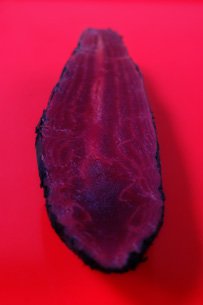
[Crapaudine Beet]
It is a common misconception that the wintertime opposes the hurried cook with a dearth of ready-to-eat vegetables that could be prepped and dressed in under five minutes.
But what of endives and young winter greens, what of radishes and kohlrabi? What of lemon-squeezed mushrooms, what of thinly sliced fennel and cabbage, what of carrots and celeriac, which do require peeling and grating, yes, but perhaps you have a basic food processor gathering dust somewhere and it is time to take it and its assorted grating-slicing attachments out of retirement?
To my arsenal of winter crudités I have a few years ago added the beetroot. While you can simply peel and grate young beets for a raw, crunchy salad — do wear gloves and an apron if you’re heading out to a job interview afterwards and don’t want to appear as if you’ve just slayed someone — I prefer to take an even more leisurely path.
I buy my beets pre-roasted from the market or the produce shop, and all I need to do is peel — the skin strips off like those cool exfoliating masks –, slice — the butter-soft flesh offers a sigh and no resistance –, and eat.
The beets I find at the organic farmers’ market are roasted over a woodfire, which accents their earthy flavor, and you can make that point with even more clarity by adding a pinch of smoked salt or smoked paprika. On my last market run I enquired about the kind of beet they used, and was told with a straight face that it was a variety called “red ass.” I smiled privately, enjoying the cheeky name, until I looked it up and realized that it was merely “red ace” with a French accent.







